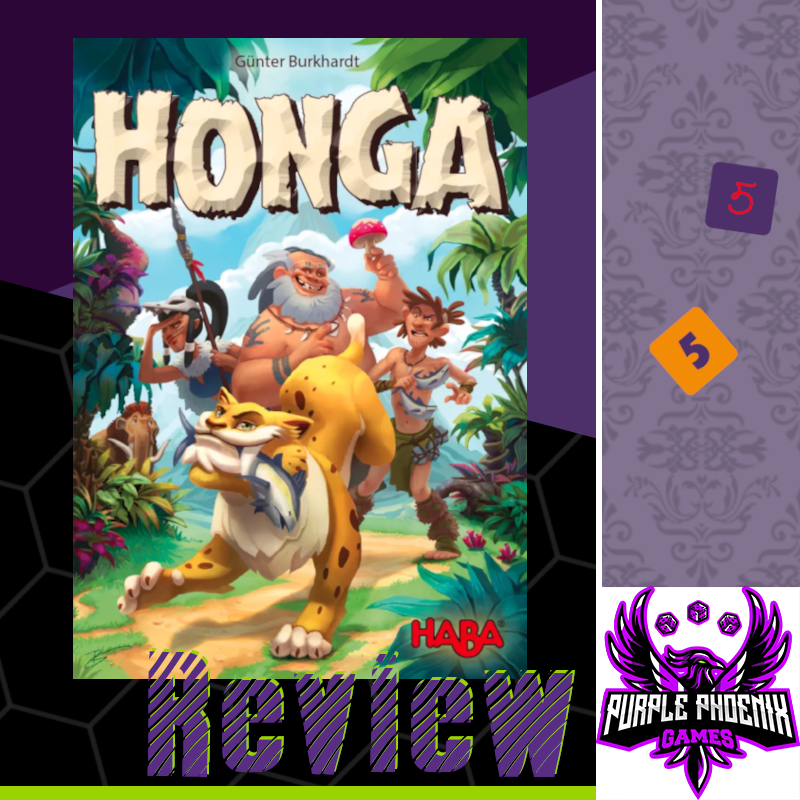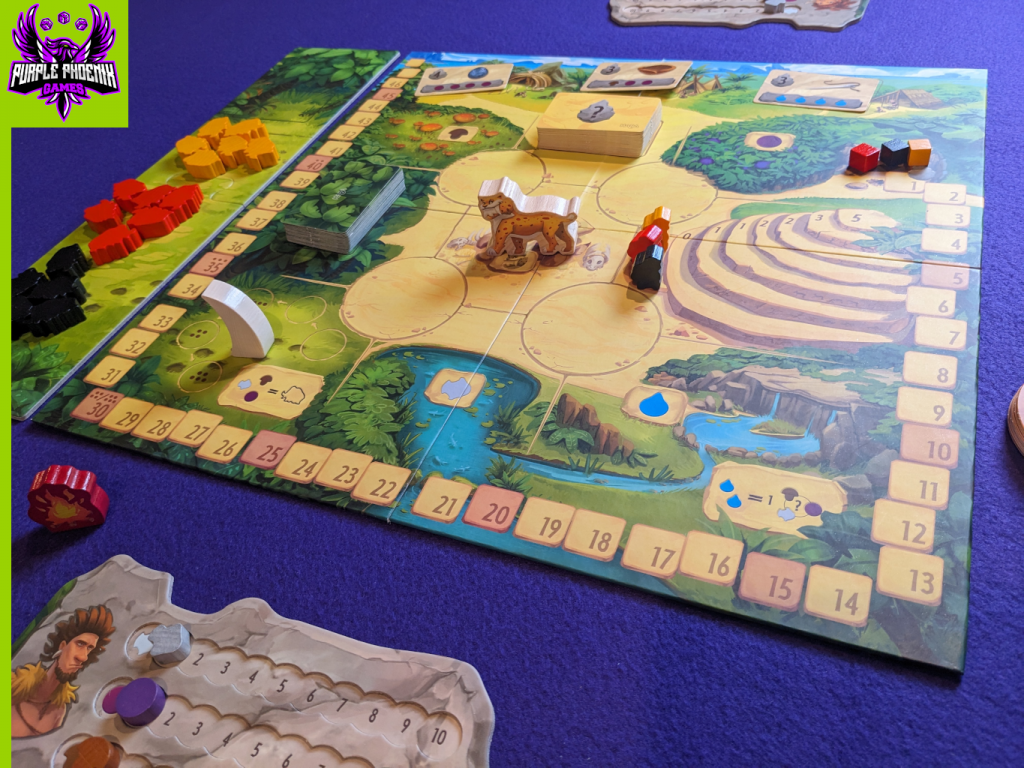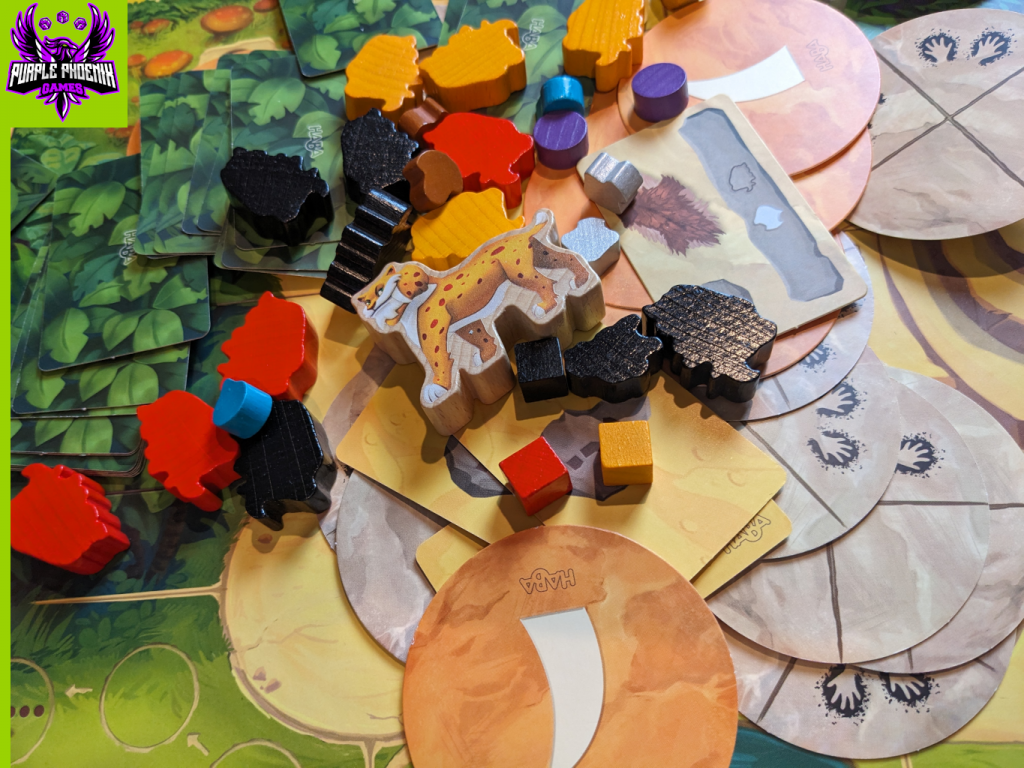
You know how you’re just chillin’ at home with your pet sabretooth tiger and then all of a sudden your neighbor decides he wants to boast about the village that he is way more religious than you? Isn’t that just a bummer? Oh, and get this: he also thinks he is able to collect the most mushrooms to attract some more mammoths? I mean, come ON who does this guy think he is?! Well I will tell you one thing – he will not be the talk of the foreign clan villages. That honor rests with me. SO EAT IT, CARL.
| Honga (2018) | HABA |
| 2-5 Players | 45 mins |
| Ages 8+ | BGG Weight – 1.93 / 5 |
Honga is a tile- and worker-placement game featuring a unique action selection mechanic for two to five players. In it, players are villagers attempting to score the most points to become the next clan leader. They do this a multitude of ways, some of which were referenced in the intro.
To setup a game, place the board in the middle of the table. Or to the side. I’m not the clan leader yet. Next to it place the mammoth depot and all the mammoths matching the chosen player colors. Each player takes a player board in their color and places a fish, berry, and mushroomeeple in the 1-space, with the watereeple in the 0 space. The card decks are separated by back type and shuffled independently. Their places on the board match the card backs, and three of the yellow barter cards are revealed as shown in the photo below. Each player places their meeple on the lowest step of the sacred mountain (religion track) and their score cube inside the cave nearby. The mammoth tusk is placed in the meadow and Honga is to patrol the middle of the board. Each player receives one gray action disc and the game is ready to begin!

Honga is played in turns, and players will conduct the following actions on their turns: place an action disc, pay attention to Honga, activate disc actions and bonus cards, and finally draw a new action disc.
The first step in a turn is to place the action disc. The active player considers the orientation of their action disc when choosing upon which of the four spaces they will place it. Discs are separated into four sections, and sections may have zero to three hand icons in a quadrant. When placed on the board the quadrants all point to a specific board action that can be taken in the third step.
The active player will then need to pay attention to Honga. Simply put, if the action disc just placed has at least one hand icon pointing to Honga in the middle of the board, he will be satisfied with the attention. Should the player neglect to give Honga attention, though, Honga will visit the player’s personal board and begin to feast on their goods. Honga will first eat one fish when visiting and at the beginning of each turn thereafter. Once the fish are gone, he will then consume berries, as they are the next good down the board. He will continue in this fashion until another player neglects to pay attention to him, or if the active player plays a specific card to kick Honga out of their hut.
Now that the disc has been placed and Honga satisfied, the active player may take appropriate board actions according to the number of hand icons pointing to the board space. Similar to paying attention to Honga, should a disc show one hand pointing to the berry patch, the active player will add one berry to their board. This is true for all other goods. Other spaces on the board will have the player collecting bonus cards, turning in goods for barter cards, allowing their meeple to advance on the sacred mountain, or even recruiting some mammoths to join the board for points. Each hand icon typically means that many of something may be collected; one hand is one berry, but three hands is three berries, etc.
Once all actions have been taken per the action disc, the active player will draw a new action disc and prepare for their next turn. However, should the active player be in control of the mammoth tusk (by recruiting more mammoths to their meadow space) they will instead draw one of the orange discs, which feature five hand icons instead of four. Cornering this market is a huge boon toward winning the game.
Play continues in this fashion until the appropriate number of VP have been reached per number of players in the game. When that has been reached, each further player in turn order may take one more turn. The player who has earned the most VP at the end will be crowned the new sabretooth clan leader!

Components. The production quality in this one is pretty great! I am a sucker for dual-layer boards, custom meeples, and big chunky wooden bits. Honga has all that and a bag of chits. Minus the bag. It was a pun. The art style is cartoony but vibrant, and is perfect for the light-hearted caveman theme. I have zero qualms about Honga’s table presence or its components. HABA did well on this one for sure.
As with many of the games in my collection, I heard about Honga from watching a runthrough by Richard Ham (Rahdo). I really enjoy the way he explains things and plays through a good number of turns to really get the feel of the game down. Now, he certainly makes a fair amount of mistakes, but I think that endears me to him even more.
This one, though, really stood out to me as a contender for my collection because of that awesome action selection disc mechanic. I don’t think I have really seen that implemented in any other game I have played, and it works so well in Honga. Having to choose between petting Honga on your turn or turning the disc to be more advantageous is one of those decision points that I love in a game. Do I sacrifice this in order to gain more of that? But if I do that, then I will pay a penalty that may nullify what I was trying to do in the first place! But if I don’t, then my opponent may get a leg up on their next turn. Oh how I love those situations!
The theme to me is really well done, and I do seem to love the theme of cavemen. Some of my favorite games are based in ancient cavemen eras (and pirates, I’m noticing). Ignoring the clan’s mascot and having him bust down your hut door to basically, “Yo, what’s up? You owe me some hugs or I’m gonna raid your stone age fridge!” I love it all!
I should really double down on controlling the mammoth tusk strategy though. Having an extra hand available on every turn really is a game changer. You wouldn’t necessarily think just one extra icon would make that much of a difference, but I know for a fact that I beat Laura last time because I controlled that thing throughout the entire game. Mammoths are a little difficult to swing, but once you have a process, it will pay off.
If you are like me and really enjoy caveman themed games with light rules and great components, then I believe you would really enjoy Honga. It is an easy teach, offers tons of choices and variability, and also provides a ton of replayability. I don’t really have another game like it in my collection, so it will be staying with me longer than Honga would with a full pantry. Purple Phoenix Games gives this one an attention-seeking 10 / 12. I encourage you to try this one with all ages and let me know if you notice one group of players enjoying it more than others. I’m interested to know. May Honga be with you in spirit.

